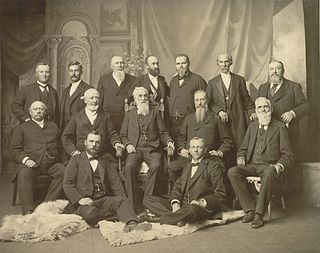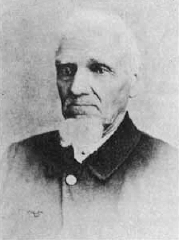
The Community of Christ, known from 1872 to 2001 as the Reorganized Church of Jesus Christ of Latter Day Saints (RLDS), is an American-based international church, and is the second-largest denomination in the Latter Day Saint movement. The church reports 250,000 members in 1,100 congregations in 59 countries. The church traces its origins to Joseph Smith's establishment of the Church of Christ on April 6, 1830. His eldest son Joseph Smith III formally accepted leadership of the church on April 6, 1860 in the aftermath of the 1844 death of Joseph Smith.

"The Family: A Proclamation to the World" is a 1995 statement issued by the Church of Jesus Christ of Latter-day Saints which defined the official position of the church on family, marriage, gender roles, and human sexuality. It was first announced by church president Gordon B. Hinckley.
Among many churches in the Latter Day Saint movement, the First Presidency is the highest presiding or governing body. Present-day denominations of the movement led by a First Presidency include the Church of Jesus Christ of Latter-day Saints, the Community of Christ, Remnant Church of Jesus Christ of Latter Day Saints, and the Righteous Branch of the Church of Jesus Christ of Latter-Day Saints.
In the Latter Day Saint movement, an apostle is a "special witness of the name of Jesus Christ who is sent to teach the principles of salvation to others." In many Latter Day Saint churches, an apostle is a priesthood office of high authority within the church hierarchy. In many churches, apostles may be members of the Quorum of the Twelve and First Presidency of the church. In most Latter Day Saint churches, modern-day apostles are considered to have the same status and authority as the Biblical apostles.

In the Church of Jesus Christ of Latter-day Saints, the Quorum of the Twelve Apostles is one of the governing bodies in the church hierarchy. Members of the Quorum of the Twelve Apostles are apostles, with the calling to be prophets, seers, and revelators, evangelical ambassadors, and special witnesses of Jesus Christ.

The Church of Jesus Christ is an international Christian religious denomination headquartered in Monongahela, Pennsylvania, United States. The church is a Christian Restorationist church, the third-largest church to believe in the Book of Mormon as scripture. The church considers itself the gospel restored, or the original church and good news as established by Jesus Christ in the New Testament, restored upon the earth. It also claims to be the spiritual successor to the Church of Christ, organized by Joseph Smith on April 6, 1830. The church sees Sidney Rigdon as Smith's rightful successor following the assassination of Smith because Rigdon was Smith's first counselor in the First Presidency. The church is not officially affiliated with any other church, organization or denomination.

The Latter Day Saint movement is a religious movement within Christianity that arose during the Second Great Awakening in the early 19th century and that led to the set of doctrines, practices, and cultures called Mormonism, and to the existence of numerous Latter Day Saint churches. Its history is characterized by intense controversy and persecution in reaction to some of the movement's doctrines and practices and their relationship to mainstream Christianity. The purpose of this article is to give an overview of the different groups, beliefs, and denominations that began with the influence of Joseph Smith.
Seventy is a priesthood office in the Melchizedek priesthood of several denominations within the Latter Day Saint movement, including the Church of Jesus Christ of Latter-day Saints. Traditionally, a Latter Day Saint holding this priesthood office is a "traveling minister" and an "especial witness" of Jesus Christ, charged with the mission of preaching the gospel to the entire world under the direction of the Twelve Apostles. Latter Day Saints teach that the office of seventy was anciently conferred upon the seventy disciples mentioned in the Gospel of Luke 10:1-2. Multiple individuals holding the office of seventy are referred to collectively as "seventies".
The First Presidency of Community of Christ, formerly the Reorganized Church of Jesus Christ of Latter Day Saints, is the church's highest-ranking priesthood quorum. It is composed of the Prophet-President and two counselors, and they preside over the whole church under the principles of "theocratic democracy" observed in the governance of the church. This includes responsibility for the World Conference, field ministries, priesthood quorums and orders, and headquarters functions. The president of the Church holds the priesthood office of Prophet and is also a High Priest.

William Smith was a leader in the Latter Day Saint movement and one of the original members of the Quorum of the Twelve Apostles. Smith was the eighth child of Joseph Smith Sr. and Lucy Mack Smith and was a younger brother of Joseph Smith Jr., the founder of the Latter Day Saint movement.
The succession crisis in the Latter Day Saint movement occurred after the murder of Joseph Smith, the movement's founder, on June 27, 1844.
A Rigdonite is a member of the Latter Day Saint movement who accepts Sidney Rigdon as the successor in the church presidency to the movement's founder, Joseph Smith Jr. The early history of the Rigdonite movement is shared with the history of the Latter Day Saint movement, but as of the 1844 succession crisis becomes distinct. Sidney Rigdon and other church leaders, including Brigham Young and James J. Strang, presented themselves as leaders of the movement and established rival church organizations. Rigdon's group was initially headquartered in Pittsburgh, Pennsylvania. It was known at one point as the Church of Jesus Christ of the Children of Zion, and its adherents are referred to as Rigdonites, or sometimes "Pennsylvania Latter Day Saints" or "Pennsylvania Mormons." The only surviving organization that traces its succession back to Rigdon's organizations is The Church of Jesus Christ, founded by a group of Rigdon's followers led by William Bickerton.
In the Latter Day Saint movement, there are two presiding high councils, one said to be "standing," and the other "traveling." The traveling high council is generally known as the Quorum of Twelve Apostles. Both councils, at least in theory, preside over the church, although the apostles have tended to supersede the standing high council in both of the largest Latter Day Saint denominations, The Church of Jesus Christ of Latter-day Saints and the Community of Christ.
The Council on the Disposition of the Tithes is a leadership body in the Church of Jesus Christ of Latter-day Saints, composed of the First Presidency, the Presiding Bishopric, and Quorum of the Twelve Apostles. The council determines how tithing funds of the church will be spent. The council oversees revenue, investments and expenditures valued at billions of dollars per year. While the LDS Church produces an annual report and employs an independent auditing department which reviews the financial activities of the church, it has not published full financial reports since 1959.
In the Latter Day Saint movement, the Quorum of the Twelve is one of the governing bodies of the church hierarchy organized by the movement's founder Joseph Smith and patterned after the Apostles of Jesus. Members are called Apostles, with a special calling to be evangelistic ambassadors to the world.
The Church of Jesus Christ (Bickertonite) is part of the Latter Day Saint movement. When Joseph Smith, the founder of the movement, died there was a dispute regarding who should lead the church as his successor. The Quorum of the Twelve, led by Brigham Young, argued that they should have the right to lead the church while one of the church leaders, Sidney Rigdon, argued that he should act as protector of the church until a permanent leader was chosen. Those who followed Rigdon formed the "Church of Christ" with its center being Pittsburgh, Pennsylvania. After an attempt to start a communitarian society, Church of Christ broke apart by 1847. William Bickerton associated himself for two years with the Church of Jesus Christ of Latter-day Saints and later left them behind refusing to accept some of their beliefs, including polygamy. In the 1850s Bickerton's preaching led to the formation of a new church in Eastern Pennsylvania. Over the following years Bickerton's church faced two schisms related to doctrinal issues. Its current official name, The Church of Jesus Christ, was adopted by 1941.

An apostle, in its literal sense, is an emissary, from Ancient Greek ἀπόστολος (apóstolos), literally "one who is sent off", from the verb ἀποστέλλειν (apostéllein), "to send off". The purpose of such sending off is usually to convey a message, and thus "messenger" is a common alternative translation; other common translations include "ambassador" and "envoy". The term in Ancient Greek also has other related meanings.

The President of the Church is the highest office of the Church of Jesus Christ of Latter-day Saints. It was the office held by Joseph Smith, the church's founder. The church's president is its leader and the head of the First Presidency, its highest governing body. Latter-day Saints consider the president of the church to be a "prophet, seer, and revelator" and refer to him as "the Prophet", a title that was originally given to Smith. When the name of the president is used by adherents, it is usually prefaced by the title "President". Russell M. Nelson has been the president since January 14, 2018.
President of the Quorum of the Twelve is a leadership position that exists in some of the churches of the Latter Day Saint movement. In these churches, the President is the head of the Quorum of the Twelve.

The following outline is provided as an overview of and a topical guide to the Church of Jesus Christ of Latter-day Saints.








